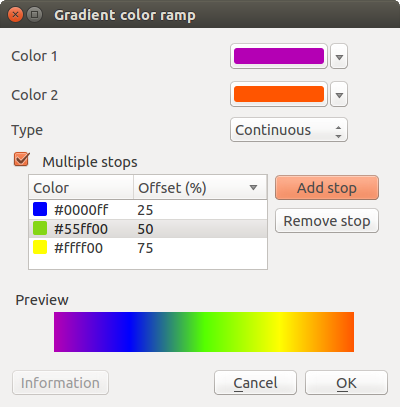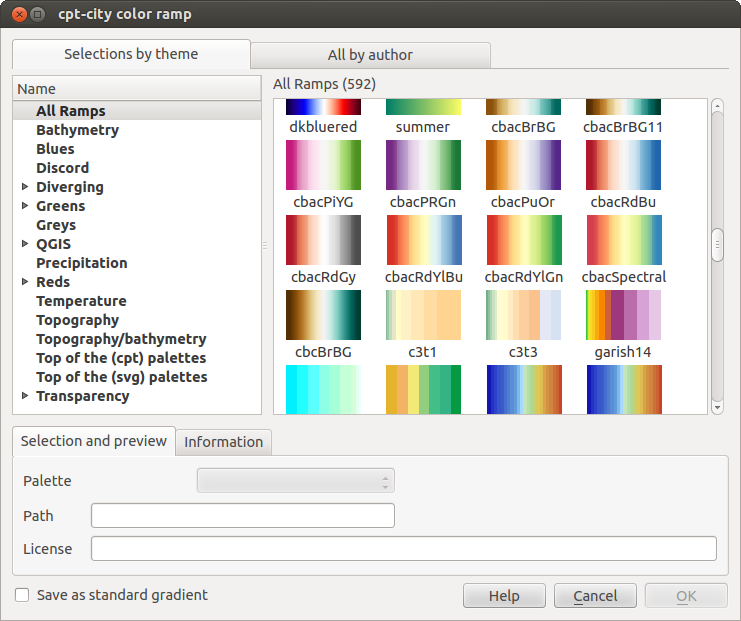.
La librería Símbolo¶
Presentation¶
The Symbol Library is the place where users can create generic symbols to be used in several QGIS projects. It allows users to export and import symbols, groups symbols and add, edit and remove symbols. You can open it with the Settings ‣ Style Library or from the Style tab in the vector layer’s Properties.
Grupos y grupos inteligentes¶
Groups are categories of Symbols and smart groups are dynamic groups.
To create a group, right-click on an existing group or on the main Groups
directory in the left of the library. You can also select a group and click
on the  add item button.
add item button.
To add a symbol into a group, you can either right click on a symbol then choose
Apply group and then the group name added before. There is a second
way to add several symbols into group: just select a group and click
 and choose Group Symbols. All symbols display a checkbox
that allow you to add the symbol into the selected groups. When finished, you can
click on the same button, and choose Finish Grouping.
and choose Group Symbols. All symbols display a checkbox
that allow you to add the symbol into the selected groups. When finished, you can
click on the same button, and choose Finish Grouping.
Create Smart Symbols is similar to creating group, but instead select Smart Groups. The dialog box allow user to choose the expression to select symbols in order to appear in the smart group (contains some tags, member of a group, have a string in its name, etc.)
Add, edit, remove symbol¶
With the Style manager from the [Symbol]  menu you
can manage your symbols. You can
menu you
can manage your symbols. You can  add item,
add item,
 edit item,
edit item,  remove item and
remove item and
 share item. ‘Marker’ symbols, ‘Line’ symbols, ‘Fill’ patterns and
‘colour ramps’ can be used to create the symbols.
The symbols are then assigned to ‘All Symbols’, ‘Groups’ or ‘Smart groups’.
share item. ‘Marker’ symbols, ‘Line’ symbols, ‘Fill’ patterns and
‘colour ramps’ can be used to create the symbols.
The symbols are then assigned to ‘All Symbols’, ‘Groups’ or ‘Smart groups’.
Para cada tipo de símbolo, siempre encontrará la misma estructura de diálogo:
- at the top left side a symbol representation
- under the symbol representation the symbol tree show the symbol layers
- at the right you can setup some parameter (unit,transparency, color, size and rotation)
- under these parameters you find some symbol from the symbols library
The symbol tree allow adding, removing or protect new simple symbol. You can move up or down the symbol layer.
More detailed settings can be made when clicking on the second level in the Symbol layers dialog. You can define Symbol layers that are combined afterwards. A symbol can consist of several Symbol layers. Settings will be shown later in this chapter.
Truco
Note that once you have set the size in the lower levels of the Symbol layers dialog, the size of the whole symbol can be changed with the Size menu in the first level again. The size of the lower levels changes accordingly, while the size ratio is maintained.
Símbolos de marcador¶
Símbolos de marcador tienen varios tipos de capas de símbolos:
Marcador de elipse
Marcador de fuente
Marcador sencillo (por defecto)
Marcador SVG
Marcador campo vectorial
The following settings are possible:
Tipo de capa de símbolo: Se tiene la opción para utilizar marcadores de elipse, marcadores de fuente, marcadores sencillos, marcadores SVG y marcadores de campo vectorial.
Colores
Tamaño
Estilo de línea exterior
Anchura de línea exterior
Ángulo
Desplazamiento X, Y: Se puede cambiar el símbolo en la dirección x- o y-.
Punto de anclaje
Propiedades definidas por datos ...
Símbolos línea¶
Símbolos de línea de marcador tienen sólo dos tipos de símbolo:
Línea de marcador
Línea sencilla (por defecto)
The default symbol layer type draws a simple line whereas the other display a marker point regularly on the line. You can choose different location vertex, interval or central point. Marker line can have offset along the line or offset line. Finally, rotation allows you to change the orientation of the symbol.
The following settings are possible:
Símbolos de polígono¶
Símbolos de marcador de polígonos también tienen varios tipos de capas de símbolo:
Relleno de centroides
Relleno de gradiente
Patrón de relleno de línea
Patrón de relleno de puntos
Relleno de imagen ráster
Relleno SVG
Relleno shapeburst
Relleno sencillo (por defecto)
Línea exterior: línea de marcador (el mismo como marcador de línea)
Línea exterior: línea sencilla (la misma como marcador de línea)
The following settings are possible:
Colores para el contorno y el relleno.
Estilo de relleno
Estilo de borde
Ancho de borde
Desplazamiento X, Y
Propiedades definidas por datos ...
Using the color combo box, you can drag and drop color for one color button to another button, copy-paste color, pick color from somewhere, choose a color from the palette or from recent or standard color. The combo box allow you to fill in the feature with transparency. You can also just click on the button to open the palettte dialog. Note that you can import color from some external software like GIMP.
Con el relleno de imagen ráster’ se puede rellenar polígonos con una imagen de trama de azulejos. Las opciones incluyen (datos definidos) nombre de archivo, opacidad, anchura de imagen (en píxeles, mm o unidades de mapa), modo de coordenadas (objeto o área de visualización) y la rotación.
‘Gradient Fill’ Symbol layer type allows you to select
between a  Two color
and
Two color
and  Color ramp setting. You can use the
Color ramp setting. You can use the
 Feature centroid as Referencepoint.
All fills ‘Gradient Fill` Symbol layer type is also
available through the Symbol menu of the Categorized and
Graduated Renderer and through the Rule properties menu of
the Rule-based renderer. Other possibility is to choose a ‘shapeburst
fill’ which is a buffered gradient fill, where a gradient is drawn from
the boundary of a polygon towards the polygon’s centre. Configurable
parameters include distance from the boundary to shade, use of color ramps or
simple two color gradients, optional blurring of the fill and offsets.
Feature centroid as Referencepoint.
All fills ‘Gradient Fill` Symbol layer type is also
available through the Symbol menu of the Categorized and
Graduated Renderer and through the Rule properties menu of
the Rule-based renderer. Other possibility is to choose a ‘shapeburst
fill’ which is a buffered gradient fill, where a gradient is drawn from
the boundary of a polygon towards the polygon’s centre. Configurable
parameters include distance from the boundary to shade, use of color ramps or
simple two color gradients, optional blurring of the fill and offsets.
Esto es posible solamente para dibujar los bordes del polígonos dentro del polígono. El uso de ‘Línea exterior: Línea sencilla’ seleccionar  Dibujar línea sólo dentro del polígono.
Dibujar línea sólo dentro del polígono.
Color ramp¶
You can create a custom color ramp choosing New color ramp...
from the color ramp drop-down menu. A dialog will prompt for the ramp type:
Gradient, Random, colorBrewer, or cpt-city. The first three have options for number of steps
and/or multiple stops in the color ramp. You can use the  Invert option while classifying
the data with a color ramp. See figure_symbology_3 for an
example of custom color ramp and figure_symbology_3a for the cpt-city dialog.
Invert option while classifying
the data with a color ramp. See figure_symbology_3 for an
example of custom color ramp and figure_symbology_3a for the cpt-city dialog.
Figure Symbology 3:
La opción cpt-city abre un nuevo diálogo con cientos de temas incluidos ‘fuera de la caja’.
Figure Symbology 3a:


